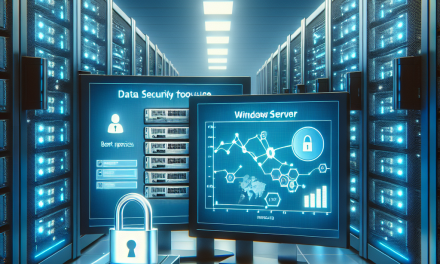As organizations increasingly rely on technology, the security of their IT infrastructure becomes paramount. Windows Server, a robust and widely adopted operating system, is no exception. Securing your Windows Server environment is critical to protecting sensitive data and maintaining business continuity. In this article, we will explore best practices for configuration and management that can significantly enhance your Windows Server security.
1. Regularly Update and Patch
One of the simplest yet most effective ways to secure your Windows Server is to ensure that it is regularly updated. Microsoft releases updates and patches that address vulnerabilities, improve stability, and enhance performance. Here’s how you can manage updates effectively:
- Enable Automatic Updates: Ensure that your server is set up to automatically download and install security updates.
- Regularly Check for Updates: Even with automatic updates enabled, manually check for updates frequently, especially after major releases.
- Use Windows Server Update Services (WSUS): WSUS allows you to manage the distribution of updates released through Microsoft Update to computers in your network, minimizing the risk of vulnerabilities.
2. Implement Role-Based Access Control (RBAC)
Controlling who has access to what is a fundamental principle of security. By implementing Role-Based Access Control (RBAC), you can minimize the risk of unauthorized access and ensure that users have only the permissions necessary for their role.
- Limit Privileged Accounts: Administrative privileges should be limited to a few trusted individuals and used only when necessary. Use standard user accounts for day-to-day tasks.
- Group Policies: Utilize Group Policies to enforce security settings and manage user roles efficiently.
3. Secure Remote Access
With the rise of remote work, securing remote access to your Windows Server is more critical than ever. Here’s how to enhance the security of your remote access methods:
- Use VPNs: Always utilize Virtual Private Networks (VPNs) for secure remote connections.
- RDP Security: If you use Remote Desktop Protocol (RDP), enforce Network Level Authentication (NLA) and restrict access to specific IP addresses whenever possible.
- Multi-Factor Authentication (MFA): Implement MFA to add an additional layer of security for remote access.
4. Enable Windows Firewall and Advanced Security Features
Windows Server includes a built-in firewall that can be configured to block unauthorized traffic. Utilize this tool to protect your server:
- Configure Inbound and Outbound Rules: Define rules based on your organization’s specific needs, allowing traffic only from trusted sources.
- Network Isolation: Consider isolating critical servers and services on separate subnets to limit exposure.
5. Regularly Back Up Your Data
Data loss can occur due to various reasons, including hardware failure or security breaches. Regular backups are essential for disaster recovery:
- Automate Backups: Use Windows Server Backup or third-party tools to automate the backup process, ensuring your data is consistently saved.
- Offsite Backups: Store backups offsite or in the cloud to protect from localized threats like ransomware attacks.
6. Monitor and Audit Logs
Monitoring and auditing logs are vital for identifying potential security incidents. Windows Server provides various logging features which should be regularly reviewed:
- Enable Auditing: Turn on audit policies to track access to sensitive files and system events.
- Security Information and Event Management (SIEM): Utilize SIEM solutions to centralize and analyze logs for suspicious activity effectively.
7. Install and Maintain Antivirus and Anti-Malware Solutions
Despite all preventive measures, malicious software can still breach your defenses. Thus, using antivirus and anti-malware solutions is crucial:
- Choose a Reputable Solution: Invest in a robust antivirus solution that offers real-time scanning and automatic updates.
- Scheduled Scans: Schedule regular scans to detect and eliminate potential threats promptly.
8. Utilize BitLocker for Data Encryption
Data encryption is a vital aspect of data protection. BitLocker Drive Encryption, built into Windows Server, helps safeguard data at rest by encrypting the entire drive:
- Enable BitLocker: Use BitLocker to encrypt servers that store sensitive information. Ensure recovery keys are securely stored.
- Regularly Update Encryption Keys: Periodically change encryption keys as part of your security maintenance routine.
Conclusion
Enhancing Windows Server security involves a combination of proactive measures and best practices in configuration and management. By staying vigilant and adhering to these guidelines, organizations can significantly reduce the risk of security breaches, protect sensitive data, and ensure the integrity of their IT infrastructure. Adopting these practices will not only fortify your Windows Server environment but also enhance your organization’s overall security posture. Remember, in the ever-evolving landscape of cyber threats, consistent monitoring and adaptation are key to robust security.
By implementing these best practices, you position your organization to enjoy the many benefits of Windows Server while minimizing the risks. For more insights on IT management and security, stay tuned to WafaTech Blogs!





